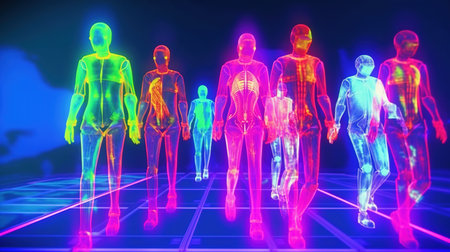Wetenschap
Hoe kies je de juiste thermograaf?
Om er zeker van te zijn dat je een goede thermograaf te pakken hebt, is het verstandig om te controleren of hij of zij een IAMT-opleiding heeft gevolgd en met de medische software van Total Vision werkt. Dan ben je namelijk verzekerd van de hoogste kwaliteit beelden, professionele begeleiding en een gedegen medische rapportage. Alle centra die op deze website vermeld staan, voldoen aan deze eisen.

Alle thermografen bij De Groene Zuster zijn aangesloten bij de IAMT; Institute for the Advancement of Medical Thermography.
Wetenschappelijke studies naar thermografie
Diverse medische studies wijzen uit dat het in beeld brengen van fysiologische processen een zeer nuttige preventieve methode is. Op Pubmed staan bijvoorbeeld meer dan 1.400 artikelen over thermografie in medische toepassingen. Hieronder staan links naar een paar zeer waardevolle artikelen.
Daarnaast hebben we ook een pagina over: De wetenschap over de bh en over diabetes & thermografie.
Onderzoek in India
Eén voorbeeld lichten we er graag even voor je uit. In India werden bij een groot onderzoek 1.008 vrouwen onderzocht in de leeftijd van 20 tot 60 jaar. Omdat veel mensen in India niet naar een kliniek kunnen gaan, was er behoefte aan een makkelijk verplaatsbare screening-tool die hen toch – in groten getale – zou kunnen bereiken. Voor thermografie zijn alleen een infraroodcamera met een statief en een laptop nodig; makkelijk te verplaatsen onderdelen dus.
Naar aanleiding van het onderzoek werden 49 vrouwen nader onderzocht vanwege temperatuurverschillen in hun borsten (verschillen hoger dan 2,5 °C). 41 van deze vrouwen bleken bij nader onderzoek borstkanker te hebben. 8 vrouwen hadden weliswaar relatief hoge temperatuurverschillen in hun borsten, maar dat bleken vrouwen te zijn die borstvoeding gaven of fibrocystische borsten hadden.
Uit dit onderzoek bleek verder dat thermografie een nauwkeurigheid heeft van 97,6%.
Lees het volledige onderzoek:
Evaluation of digital infra-red thermal imaging as an adjunctive screening method for breast carcinoma
The Screening of Well Women for the Early Detection of Breast Cancer Using Clinical Examination with Thermography and Mammography.
Researchers screened 4,621 asymptomatic women, 35% whom were under age 35 y.o. and detected 24 cancers (7.6 per 1000) with a sensitivity and specificity of 98.3% and 93.5% respectively
Breast Thermography and Cancer Risk Prediction.
From a patient base of 58,000 women screened with thermography, researchers followed 1,527 patients with initially healthy breasts and abnormal thermograms for 12 years. Of this group, 40% developed malignancies within 5 years. The study concluded that “an abnormal thermogram is the single most important marker of high risk for the future development of breast cancer”
A Perspective on Medical Infrared Imaging.
Since the early days of thermography in the 1950s, image processing techniques, sensitivity of thermal sensors and spatial resolution have progressed greatly, holding out fresh promise for infrared (IR) imaging techniques. Applications in civil, industrial and healthcare fields are thus reaching a high level of technical performance. In many diseases there are variations in blood flow, and these in turn affect the skin temperature. IR imaging offers a useful and non-invasive approach to the diagnosis and treatment (as therapeutic aids) of many disorders, in particular in the areas of rheumatology, dermatology, orthopaedics and circulatory abnormalities. This paper reviews many usages (and hence the limitations) of thermography in biomedical fields.
Efficacy of Computerized Infrared Imaging Analysis to Evaluate Mammographically Suspicious Lesions.
Compared results of Infrared imaging prior to biopsy. The researchers determined that Thermography offers a safe, noninvasive procedure that would be valuable as an adjunct to mammography in determining whether a lesion is benign or malignant with a 99% predictive value.
Does Infrared Thermography Truly Have a Role in Present Day Breast Cancer Management?
Spitalier and associates screened 61,000 women using thermography over a 10 year period. The false negative and positive rate was found to be 11% (89% sensitivity and specificity). 91% of the nonpalpable cancers (T0 rating) were detected by thermography. Of all the patients with cancer, thermography alone was the first alarm in 60% of cases. The authors noted “in patients having no clinical or radiographic suspicion of malignancy, a persistent abnormal breast thermogram represents the highest known risk factor for the future development of breast cancer”
A Hybrid cost-sensitive ensemble for imbalanced breast thermogram classification
For a challenging dataset of about 150 thermograms, our approach achieves an excellent sensitivity of 83.10%, while maintaining a high specificity of 89.44%. This not only signifies improved recognition of malignant cases, it also statistically outperforms other state-of-the-art algorithms designed for imbalanced classification, and hence provides an effective approach for analysing breast thermograms.


